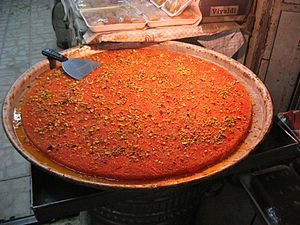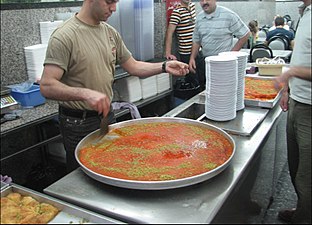Knafeh
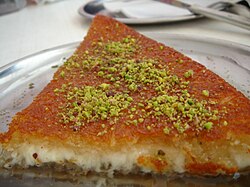 | |
| Alternative names |
|
|---|---|
| Type | Dessert |
| Place of origin | Nablus[1] |
| Region or state | |
| Serving temperature | Warm, room temperature or cold (qishta variety) |
| Main ingredients | |
| Variations | Multiple |
Knafeh
In Arabic, the name may refer to the string pastry itself, or to the entire dessert dish. In Turkish, the string pastry is known as tel kadayıf, and the cheese-based dessert that uses it as künefe. In Turkey, it is called künefe.[10] In the Balkans, the shredded dough is similarly known as kadaif/cataif,[11] and in Greece as kadaifi, and is the basis of various dishes rolled or layered with it, including dessert pastries with nuts and sweet syrups.
Etymology
The English language borrows the word "knafeh" from Levantine and Egyptian Arabic, and widely transliterates it as kanafeh, kenafeh, knafeh, kunafah, kunafeh, konafa, knéfé, kunafa, and similar variations.[12][13]
The ultimate origin of kanafeh is debated. Some sources state that it comes from the Coptic Egyptian word "kenephiten", meaning a bread or cake.[14][15][12][16] Early attestations are found in stories like One Thousand and One Nights.[12] Another view is that it comes from a Semitic root with a meaning of "side" or "wing", from the Arabic kanafa, "to flank or enclose".[17][18]
History
A common story is that the dish was created, and prescribed by doctors, to satisfy the hunger of

The 13th century anonymous Kitab al tabikh fi-l-Maghrib wa-l-Andalus (Book of Dishes from Maghreb and Al-Andalus) uses the word 'kunāfa' to describe a crêpe made with thin batter on an Indian pan or "mirror" (the tābaq), and says it is equivalent to ruqāq. It also gives a recipe for Abbasid Qatāyif (the crêpes being called musahhada in Al-Andalus), which uses the same batter, but the kunāfa is made thinner, "like a fine tissue". It gives a number of dessert recipes for kunāfa, where the crêpes are served layered with fresh cheese, baked, and topped with honey and rose syrup; or cut up into shreds like rose leaves and cooked with honey, nuts, sugar, and rosewater.[25][6]
In the later Middle Ages, a new technique was created, with thin batter being dripped onto the metal sheet from a perforated container, creating hair-like strings. A mid-15th century Ottoman Turkish translation of Muhammad bin Hasan al-Baghdadi's Kitab al-Tabikh added several new contemporary recipes, including one for this kadayif, though it does not specify where it originated.[27] This became the basis for the modern kunafa/kanafeh. It is fried together with butter and fillings or toppings such as nuts, sweetened cheese, or clotted cream, and mixed with rosewater and sugar. The pastry spread from the Arab lands to neighboring countries including Iran and Greece, and to Turkey where the string pastry itself is known as tel kadayıf ("string crêpes"), also used in related pastries such as dolma kadayif.[6]
Preparation


There are many types of kanafeh pastry:
- khishnah (Arabic: خشنة, rough): crust made from long thin noodle threads.
- nāʿimah (Arabic: ناعمة, fine): semolina dough.
- muhayara (Arabic: محيرة, mixed): a mixture of khishnah and na'ama.
- mabruma (Arabic: مبرومة, twined): It is prepared with noodle.
The pastry is heated in butter, margarine, palm oil, or traditionally
Variants
Kanafeh Nabulsieh
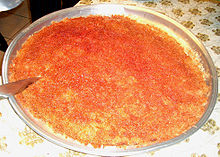
Kanafeh Nabulsieh originated in the
Kadayıf and künefe
In the
The EU Commission approved ‘Antakya Künefesi' from Hatay, Türkiye as
Riştə xətayi
This northern Iranian variant is prepared in Tabriz, Iran. Riştə xətayi is typically cooked in Ramadan in the world's biggest covered Bazaar of Tabriz. It is made with chopped walnuts, cinnamon, ginger, powder of rose, sugar, rose water and olive oil.[33]
Kadaif
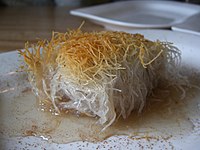
In this variant, called also καταΐφι (kataïfi) or κανταΐφι (kadaïfi) in Greek, the threads are used to make various forms of pastries, such as tubes or birds' nests, often with a filling of chopped nuts as in baklava.
These very thin threads are also known as "kadaif noodles" and are used to make the outer shell of the Greek dessert kataifi. These vermicelli-like threads become very crispy when fried or baked. For this particular Greek dessert, the filling is usually a blend of coarsely chopped nuts, such as walnuts and pistachios, mixed with honey and a light cream.[34]
Gaza knafeh
This variant originated in Gaza Strip, Palestine, and is made of soft bulgur, cinnamon, pecan nuts, and dairy fats.[35]
World records
The world's largest plate of the dessert was made in Antakya, Turkey, in 2017. The tray of künefe measured 78 meters long, and weighed 1550 kilograms.[36] A previous record attempt was made in Nablus in 2009, with a 75-meter tray, weighing 1,350 kilograms.[37] Neither attempt was officially listed as breaking the record; according to the website of the Guinness World Records, there is no current record holder for the title.[38]
See also
- List of pastries
- Palestinian cuisine
- Phyllo
- Qatayef, a dumpling-like confection involving some of the same ingredients
Gallery
-
Knafeh in Jerusalem
-
Knafeh (na'ama) fine
-
Knafeh Nabulsieh
-
Knafeh shop, old city of Jerusalem
-
Knafeh with pistachio
References
- ISBN 978-0-520-96079-4.
- ^ "knafeh". dictionary.cambridge.org. Retrieved 2021-08-14.
- ^ "Cheese pastry (künefe)".
- ^ "Tel kadayıf hamuru tarifi". Hurriyet.
- ISBN 9780313342639.
- ^ ISBN 9780199677337– via Google Books.
- ^ "Knafeh". Time Out Sydney.
- ^ ISBN 9781449618117.
- ISBN 9780863568794.
- ISBN 9780313376269. Retrieved 2014-12-02.
- OCLC 50590735.
- ^ a b c "Etymological Dictionary of Arabic". Bibliotheca Polyglotta. University of Oslo. Retrieved 11 October 2020.
- ISBN 9780544186316– via Google Books.
- ISSN 0458-3035. Archived from the originalon 7 December 2015. Retrieved 2018-07-12 – via LA Times.
- OCLC 897473661.
- ISBN 9780199313396– via Google Books.
- ^ The Editors of the American Heritage Dictionaries. "Appendix II - Semitic Roots". American Heritage Dictionary. Houghton Mifflin Harcourt. Retrieved July 12, 2018.
- ^ Team, Almaany. "Definition and meaning of Kanafeh in Arabic in the dictionary of the meanings of the whole, the lexicon of the mediator, the contemporary Arabic language - Arabic Arabic dictionary - Page 1". www.almaany.com.
- Cairo Post. 6 July 2015. Archived from the originalon 2018-07-12. Retrieved 2018-07-12.
- ^ "20 places to get amazing kunafa and Arabic sweets in the UAE". gulfnews.com. 2021-04-14. Retrieved 2023-12-24.
- ISBN 9781610692212.
- ISBN 978-0-688-15305-2.
- ^ Al-awsat, Asharq (4 October 2007). "The Ramadan Experience in Egypt - ASHARQ AL-AWSAT English Archive". ASHARQ AL-AWSAT English Archive. Retrieved 2018-06-18.
- ISBN 9789047423058.
- ^ "An Anonymous Andalusian Cookbook of the 13th Century". www.daviddfriedman.com. Retrieved 2018-07-12. See also contents and footnotes.
- ISBN 9789004281561– via Google Books.
- ISBN 9781848858985– via Google Books.
- ^ "Kunafa". Sampateek. 9 October 2013. Archived from the original on 9 November 2017. Retrieved 8 November 2017.
- ISBN 9781477283097.
- ^ Cuisine Archived 2007-08-04 at the Wayback Machine Institute for Middle East Understanding
- ^ "Künefe – ein außergewöhnliches Dessert". nobelio.de. Archived from the original on 2016-03-25. Retrieved 2014-12-02.
- ^ "EUR-Lex - 52022XC1115(02) - EN - EUR-Lex". eur-lex.europa.eu. Retrieved 2023-03-17.
- ^ Behnegarsoft.com. "اهراب نیوز - تصویری/ رشته ختایی؛ شیرینی مخصوص تبریز برای رمضان". ahrabnews.com. Archived from the original on 2014-10-06. Retrieved 2014-12-02.
- ^ "What is Kataifi?". Gourmet Flyer. August 22, 2021. Retrieved November 28, 2022.
- ^ Berger, Miriam. "The Palestinian dessert few can enjoy". www.bbc.com. Retrieved 2021-12-04.
- ^ "78-meter-long künefe dessert eaten in 20 minutes in Turkey's Hatay". Hürriyet Daily News. Retrieved 2018-07-14.
- ^ "WEST BANK: Palestinian Knafeh enters Guinness World Records". Itnsource.com. Retrieved 2015-05-21.
- ^ "Search Results – Guinness World Records". Retrieved 2018-07-14.
External links
 Media related to Kanafeh at Wikimedia Commons
Media related to Kanafeh at Wikimedia Commons

